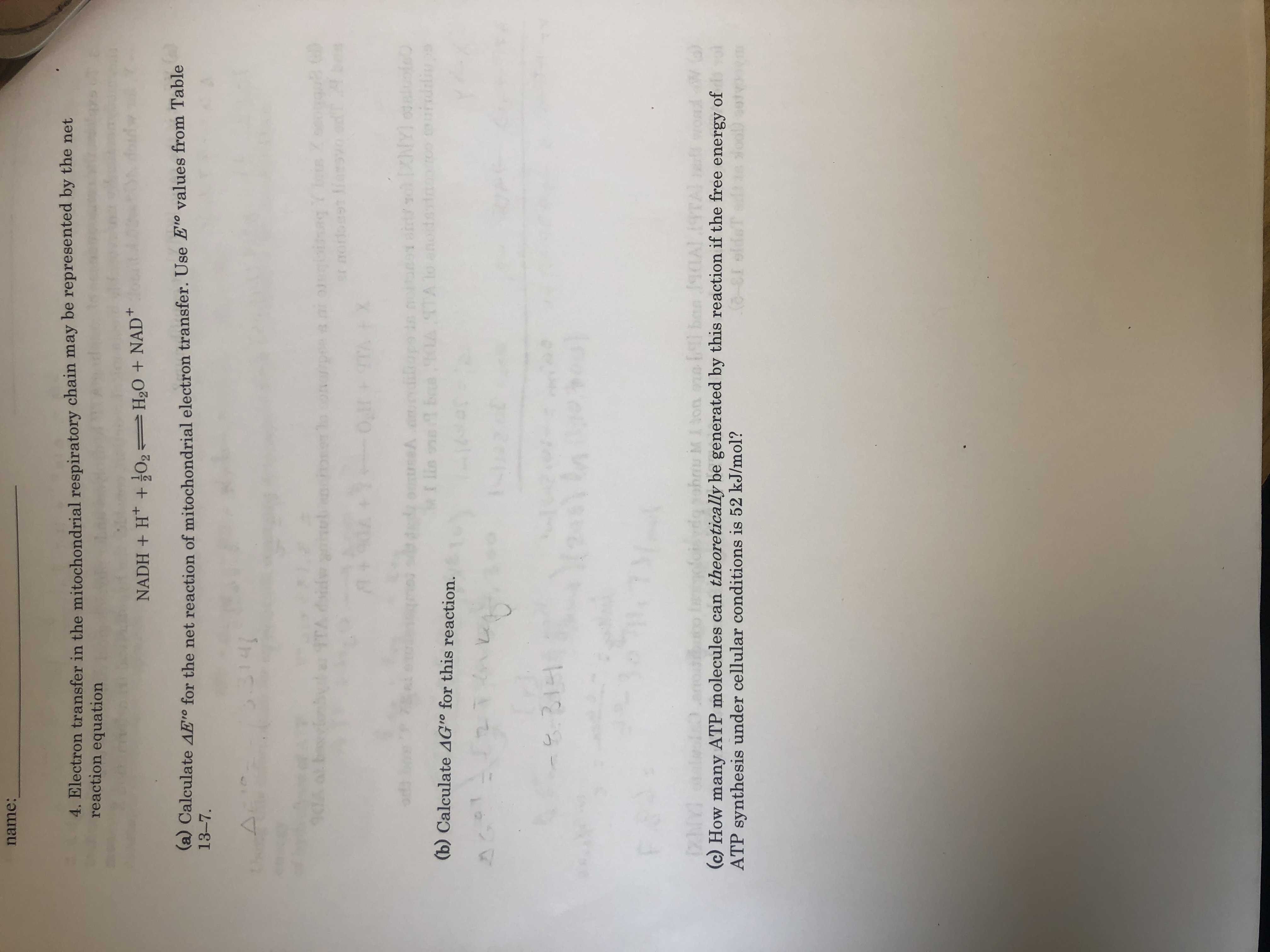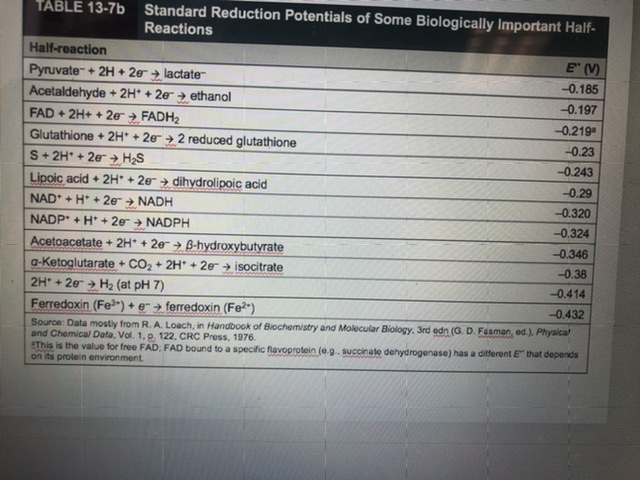
Chemistry
10th Edition
ISBN: 9781305957404
Author: Steven S. Zumdahl, Susan A. Zumdahl, Donald J. DeCoste
Publisher: Cengage Learning
expand_more
expand_more
format_list_bulleted
Question

Transcribed Image Text:name:
4. Electron transfer in the mitochondrial respiratory chain may be represented by the net
reaction equation
H20 + NAD*
NADH + H* + 02
(a) Calculate AE'° for the net reaction of mitochondrial electron transfer. Use E'° values from Table
13-7.
sinag Yn
t noroest lierodT
ITA did
XNY) oalote
dalipe
A TAlo ano
b
Mt lln s
(b) Calculate AG° for this reaction.
-&.314
fodg ohnu iM
(xMY)
(c) How many ATP molecules can theoretically be generated by this reaction if the free energy of
ATP synthesis under cellular conditions is 52 kJ/mol?
ono l ban 9IA TTA

Transcribed Image Text:TABLE 13-7b
Standard Reduction Potentials of Some Biologically Important Half-
Reactions
Half-reaction
E (V)
Pyruvate+ 2H + 2e + lactate
-0.185
Acetaldehyde + 2H* + 2e → ethanol
FAD + 2H+ + 20 FADH2
-0.197
-0.219
Glutathione + 2H + 2e
S+ 2H* + 2e+ H;S
2 reduced glutathione
-0.23
-0.243
Lipoic acid + 2H* + 2e → dihydrolipoic acid
-0.29
NAD* + H* + 2e
NADH
-0.320
NADP + H* + 2e + NADPH
-0.324
Acetoacetate + 2H* + 2e > B-hydroxybutyrate
a-Ketoglutarate + CO2 + 2H* + 2er + isocitrate
2H + 2e > H2 (at pH 7)
Ferredoxin (Fe3*) + e> ferredoxin (Fe2")
-0.346
4.
-0.38
-0.414
-0.432
Source: Data mostly from R. A. Loach, in Handbook of Biochemistry and Molecular Biology, 3rd edn (G. D. Fasman, ed.), Physical
and Chemical Data, Vol. 1, p. 122, CRC Press, 1976.
SThis is the value for free FAD; FAD bound to a specific flavoprotein (e.g. succinate dehydrogenase) has a ditferent E" that depends
on its protein environment.
Expert Solution
This question has been solved!
Explore an expertly crafted, step-by-step solution for a thorough understanding of key concepts.
This is a popular solution
Trending nowThis is a popular solution!
Step by stepSolved in 3 steps with 3 images

Knowledge Booster
Similar questions
- Considering the reaction and the information in the Excel table below, what should be entered into cell D3 to calculate Kc? Fe3+(aq) + 2 SCN (aq) = Fe(SCN),"(aq) (bp).2( A 1 Equilibrium Concentration (M) B 2 Fe3+ SCN Fe(SCN)2+ Equilibrium Constant 3 9.70E-04 1.70E-04 2.60E-05 =C3/(A3*B3^2) O =C3/(A3^2*B3) O =A3*B3^2/C3 O =C3/(A3*B3)^2 O =C3/(A3*B3)arrow_forwardPlease answer fast I'll rate you surearrow_forwardConsider the following acidic reaction at constant temperature: HCIO2 (aq) H+ (aq) + CIO2 (aq), Ka = 0.011 Calculate [HCIO2leq if [HCIO2]0 = 0.072 M.arrow_forward
- 7. Given the following information, find K, for nitrous acid, HNO2. NO3 + 3H+ + 2e HNO₂ + H₂O E° = 0.940 V E' = 0.433 Varrow_forwardurgentarrow_forwardConsidering the reaction and the information in the Excel table below, what should be entered into cell D3 to calculate Kc? A B C D 1 Equilibrium Concentration (M) 2 Fe3+ SCN- Fe(SCN)2+ Equilibrium Constant 3 9.70E-04 1.70E-04 2.60E-05 =C3/(A3*B3)^2 =C3/(A3^2*B3) =A3*B3^2/C3 =C3/(A3*B3) =C3/(A3*B3^2)arrow_forward
- 26. For which of these reactions will the sign of AG° be negative as written in aqueous solution at 298 K? What is the value of AG for these reactions at equilibrium? i. CI3CCOOH(aq) = H*(aq) + Cl3CCo0 (aq)arrow_forwardA concentration cell is constructed having Zn elelctrodes in two ZnSO4 solutions A and B. At 25°C, the osmotic pressure of the two solutions are 56.3 atm and 0.563 atm, respectively. Calculate the Ecell, assuming no ion pair formation. Pi= iMRTarrow_forward
arrow_back_ios
arrow_forward_ios
Recommended textbooks for you
 ChemistryChemistryISBN:9781305957404Author:Steven S. Zumdahl, Susan A. Zumdahl, Donald J. DeCostePublisher:Cengage Learning
ChemistryChemistryISBN:9781305957404Author:Steven S. Zumdahl, Susan A. Zumdahl, Donald J. DeCostePublisher:Cengage Learning ChemistryChemistryISBN:9781259911156Author:Raymond Chang Dr., Jason Overby ProfessorPublisher:McGraw-Hill Education
ChemistryChemistryISBN:9781259911156Author:Raymond Chang Dr., Jason Overby ProfessorPublisher:McGraw-Hill Education Principles of Instrumental AnalysisChemistryISBN:9781305577213Author:Douglas A. Skoog, F. James Holler, Stanley R. CrouchPublisher:Cengage Learning
Principles of Instrumental AnalysisChemistryISBN:9781305577213Author:Douglas A. Skoog, F. James Holler, Stanley R. CrouchPublisher:Cengage Learning Organic ChemistryChemistryISBN:9780078021558Author:Janice Gorzynski Smith Dr.Publisher:McGraw-Hill Education
Organic ChemistryChemistryISBN:9780078021558Author:Janice Gorzynski Smith Dr.Publisher:McGraw-Hill Education Chemistry: Principles and ReactionsChemistryISBN:9781305079373Author:William L. Masterton, Cecile N. HurleyPublisher:Cengage Learning
Chemistry: Principles and ReactionsChemistryISBN:9781305079373Author:William L. Masterton, Cecile N. HurleyPublisher:Cengage Learning Elementary Principles of Chemical Processes, Bind...ChemistryISBN:9781118431221Author:Richard M. Felder, Ronald W. Rousseau, Lisa G. BullardPublisher:WILEY
Elementary Principles of Chemical Processes, Bind...ChemistryISBN:9781118431221Author:Richard M. Felder, Ronald W. Rousseau, Lisa G. BullardPublisher:WILEY

Chemistry
Chemistry
ISBN:9781305957404
Author:Steven S. Zumdahl, Susan A. Zumdahl, Donald J. DeCoste
Publisher:Cengage Learning

Chemistry
Chemistry
ISBN:9781259911156
Author:Raymond Chang Dr., Jason Overby Professor
Publisher:McGraw-Hill Education

Principles of Instrumental Analysis
Chemistry
ISBN:9781305577213
Author:Douglas A. Skoog, F. James Holler, Stanley R. Crouch
Publisher:Cengage Learning

Organic Chemistry
Chemistry
ISBN:9780078021558
Author:Janice Gorzynski Smith Dr.
Publisher:McGraw-Hill Education

Chemistry: Principles and Reactions
Chemistry
ISBN:9781305079373
Author:William L. Masterton, Cecile N. Hurley
Publisher:Cengage Learning

Elementary Principles of Chemical Processes, Bind...
Chemistry
ISBN:9781118431221
Author:Richard M. Felder, Ronald W. Rousseau, Lisa G. Bullard
Publisher:WILEY